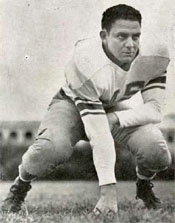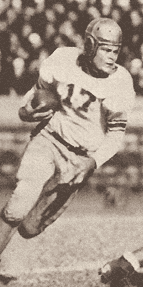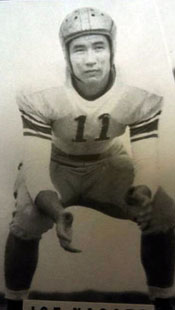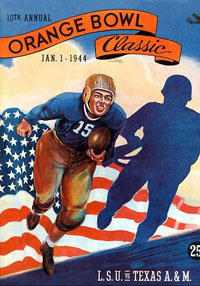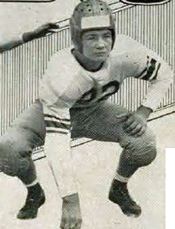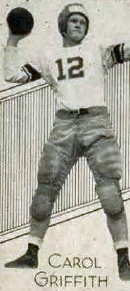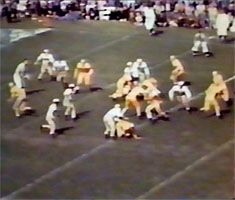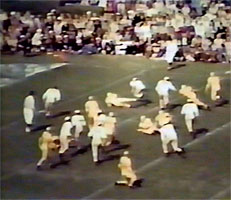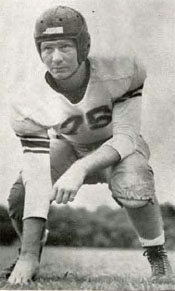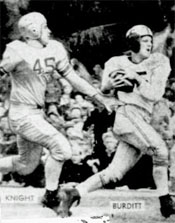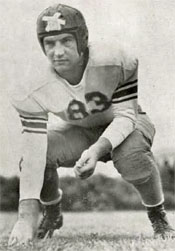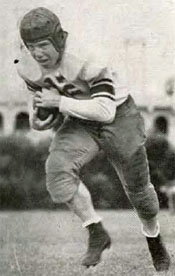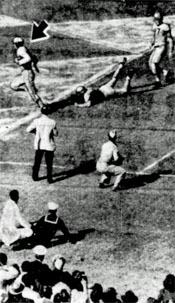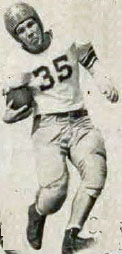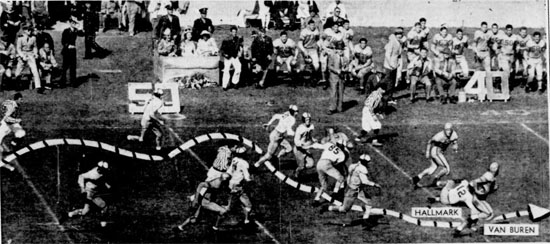Tiger Bowl Games – 1944 Orange Bowl
|
Top of Page |
Due to the fact that World War II drained college-age manpower, only four of the twelve SEC schools fielded football teams in 1943: LSU, Tulane, Georgia, and Georgia Tech.
- This reflected a national trend in which 150 colleges abandoned football that season.
- Many military bases fielded football teams that competed against college teams. The most famous was the Great Lakes Naval Training Center.
Bernie Moore's LSU squad consisted of two groups of players.
- Those who had been rejected for military service for some reason. For example, star RB Steve Van Buren failed his army physical because of defective vision.
- Students too young for the draft who could play for a year before entering the service.
LSU lacked the Navy V-12 training program that provided manpower for teams at other schools.
- The purpose of the program was to train future officers by providing them with a bachelor's degree as a stepping stone to attending a U.S. Naval Reserve Midshipmen's School for four months to obtain a commission as an ensign.
- Both Tulane and Georgia Tech participated in the V-12 program which benefitted their football teams because the Navy allowed its trainees to play sports.
- Some V-12 programs fielded their own football teams. The Iowa Pre-Flight Seahawks finished second to Notre Dame in the final AP poll for 1943.
Led by Van Buren, the Tigers compiled a 5-3 record, going 2-2 in the SEC.
- How could LSU end up 2-2 in the SEC when there were only three other opponents? Simple - they played Georgia twice, once in Tiger Stadium to open the season (34-27 victory) and again in Athens (27-6 triumph).
- Another of the victories came at the expense of LSU's Army Specialized Training Program team. The Army program had a different purpose from the Navy's V-12 program. The primary goal of the ASTU was to turn out technically-trained personnel and not officers. The ASTU program was also of shorter duration (typically 18 months) since it did not lead to a bachelor's degree.
- The Tiger losses came in their last two games to Georgia Tech (42-7) and Tulane (27-0). Van Buren suffered an ankle injury in the second quarter of the Tech game and didn't play at all against the Green Wave. One of Tulane's stars was Dub Jones, who had played for LSU in 1942 before joining the V-12 program in New Orleans.
LSU's other defeat occurred in the third game against Texas A&M, another V-12 school, in Baton Rouge 28-13.
- Having won their first two, the Tigers entered the contest ranked #17 in the AP poll.
- Called by the Associated Press writer of the game report as "an eleven man track team in football toggery," the young Aggies, dubbed the "Kiddie Corps" by the press, beat the larger Tigers 28-13 before a Saturday night crowd of 25,000.
- Van Buren didn't enjoy the success he had against Georgia and Rice. His best work came when he started to pass, then ran, including a 38y jaunt down the sidelines for a TD.
- The key difference in the game was A&M's passing prowess: 110y to 37 for LSU. The Tigers had one more first down, 10-9, and outgained the visitors on the ground, 198-123.
It was amazing that Texas A&M could beat anyone in 1943 after a whopping 77 members of Homer Norton's '42 squad entered the military during the summer. The Aggies coach was left with four players. So he threw out a wide net on campus, asking, Are there 11 men in the student body who can play football? The student newspaper made its own pitch. It is time for the twelfth man to rise up from the student body and offer his services to the corps. This is a necessary action to take in order that varsity sports will continue at Texas A&M. Turn out, twelfth man.
135 students responded. Of the 75 Norton chose, only one had played college football. The rest were freshmen. The average age was 17.5. Sportswriters called the Aggies "a glorified high school football team." But some had not even played in high school.
Four members of the Kiddie Korps made the All-Southwest Conference team: Marion Flanagan, M. E. Settegast, Goble Bryant, and Jim Hallmark.
The five bowls that existed at the time - Rose, Sugar, Orange, Cotton, and Sun - faced slim pickings.
- The Sugar Bowl, which had chosen an SEC team seven of its first nine years (including LSU three times), selected Georgia Tech to face Tulsa.
- The Cotton Bowl went with Texas against Randolph Field, an army air corps base near San Antonio.
- With Van Buren the drawing card, the Orange Bowl arranged a rematch between LSU and 6-2-1 Texas A&M.
- Coach Moore was pleased with the bowl bid. All we hoped to do when the season started was keep football alive.
14-to-15-point underdogs, the Tigers hoped to exact revenge on the Aggies and win their first bowl game after three failures.
- Moore and his staff knew they had to do something different from the first meeting to help Van Buren get loose.
- So they moved 165 lb wingback from Eunice, Joe Nagata, to fullback. They didn't do this because of Nagata's blocking. The plan called for Joe to take direct snaps from center in LSU's version of the Notre Dame box. Joe stepped forward, pivoted left or right, and handed the ball to Van Buren. The intent was to freeze the A&M linebackers for a moment to give Steve an extra step.
- Nagata would occasionally keep the ball and run up the middle.
- Van Buren injured his ankle in the Georgia Tech game but was expected to be in top form by the New Year.
- The Aggies would play without the nation's top receiver in terms of yardage, Marion Flanagan. He injured a knee in the Thanksgiving game against Texas.
Traveling to Miami for the game was no simple matter thanks to wartime regulations that gave priority to troop movements.
- With trains not an option, the Tigers benefitted from the largesse of Baton Rouge banker Lewis Gottleib.
- He purchased eighteen used cars to transport the players. He later sold the cars at his automobile agency.
An overflow crowd of 25,203 saw the action, and listeners around the world heard Ted Husing's call on Armed Forces radio. Counting servicemen let in free, over 30,000 saw the game.
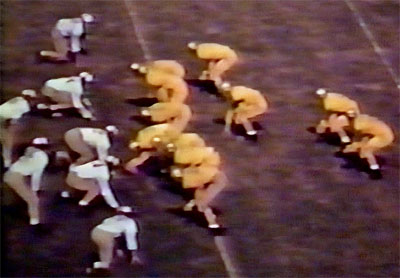
LSU Offense with Van Buren at TB and Nagata at his right early in Q1
(from video of 1944 Orange Bowl made from coaches film)
- Moore wasted little time in deploying his new offensive scheme. The result was two touchdowns before A&M awoke.
After neither team went far on its first possession, the Bengals started at their 41 with a brisk wind at their back. The Tigers pulled one of several fancy plays they had prepared for the rematch. Van Buren passed 15y to Carroll Griffith who, as he was being thrown to the ground, lateralled to E Charley Webb who rumbled to the A&M 32.

Van Buren throws to Griffith, who will lateral to Webb.
During the period, LSU lost big T Earl Tullos for the rest of the contest.
- When LSU got the ball back, Van Buren unleashed a 51y rolling quick kick that "Red" Burnitt unwisely tried to pick up only to fumble it. Webb wrestled it away from him at the A&M 22. After two running plays gained only 2y, Barney reentered the huddle with more instructions from the sideline. Van Buren rolled right, stopped, and passed across the field to Burt Goode who snagged the ball as he crossed the goal. Steve's PAT try failed. LSU 12 Texas A&M 0
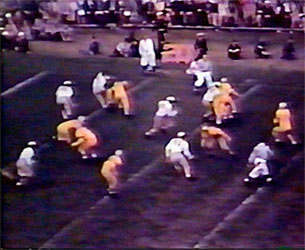 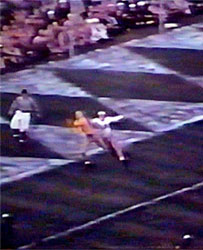
Van Buren starts around RE, stops, and throws across the field to Burt Goode at the goal line.
- With Van Buren taking a rest, the Aggies wasted little time getting back in the game. They took the kickoff and, starting from their 30, unleashed the aerial attack that had knocked the Tigers for a loop in Baton Rouge. After three straight completions and a 15y roughness penalty, A&M found themselves on the LSU 20. TB Jim "Babe" Hallmark passed to Burnitt, who made a nice grab just inside the end zone to atone for his earlier miscue. Bing Turner added the point. LSU 12 Texas A&M 7 End of Quarter

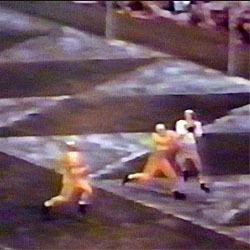
Jim Hallmark passes to "Red" Burnitt for the Aggies' first TD.
Burnitt's story was typical of the 1943 Kiddie Korps. He recalled: For me personally it was a dream come true to be playing for the Aggies. My father was class of '21. From the day I can remember the only thing I ever wanted to do was go to Texas A&M and play football. But coming out of Abilene High School [where he graduated at midterm], I arrived at A&M in the spring of '43 thinking I had no chance to play. I didn't even come to spring practice because I weighed only 158 pounds. But that summer [A&M] put an article in the paper saying that he needed football players. I was pretty cocky and said, "Hey, give me a uniform and I think I can make your football team." I wasn't very big, but I had run a 9.7 in the 100-yard dash in high school. And I had a burning desire to prove I could play.
- Shortly after the second period began, the Aggies picked up where they left off on their previous possession. Burnitt took a flat pass and rambled to the LSU 30, but a Tiger took the ball away from him during the tackle.
After failing to gain a first down, the Tigers lined up in punt formation. Van Buren took the snap and, with several rushers storming in, took off over the right side on a meandering run during which he broke three tackles. He seemed to run out of gas, slowing to a walk at the A&M 25 where he was easily tackled. Steve stayed down for a while before leaving the game to recharge his batteries.

Van Buren on the loose after dropping back to punt.
A&M immediately punted out of danger, Van Buren returning the boot to midfield.
The Tigers pushed to the 15 before running out of downs.
After a clipping penalty pushed them back, the Aggies again punted from their end zone, Steve returning to the 16. But after four downs, the Aggies reclaimed the ball at that spot.
Staying on the ground deep in their territory, the Lone Star boys ran out the clock.
LSU had dominated the period but had no points to show for it.
Halftime score:
LSU 12 Texas A&M 7
A cast of hundreds filled the field at halftime for another of the Orange Bowl's spectacular pageants.
This one saluted the United States and her World War II allies.
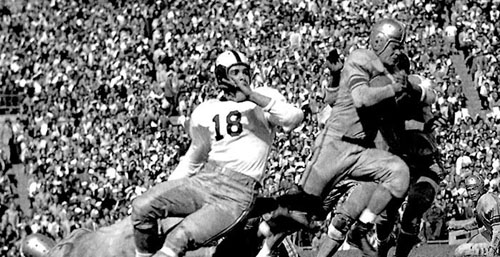
Steve Van Buren runs against Texas A&M .
The teams traded touchdowns in the third quarter.
- On the third snap after the kickoff, Big Steve showed his All-American form by breaking loose for 62y through the entire Aggie team. This time he converted. LSU 19 Texas A&M 7
- Down by 12 again, A&M took to the air with a strong breeze at their backs and moved to the LSU 48 before having to punt.
On the first play from the 20, Nagata fumbled, and Butch Butchofsky recovered for A&M on the 25. After a 7y pass followed by an incompletion, Hallmark shot another one to Marion Settegast running across on the five, and the big end did the rest himself. Turner booted the point to reduce the margin to five again. LSU 19 Texas A&M 14
- The fray settled into a defensive battle the rest of the way. Neither side came close to scoring the rest of the third quarter, with the Aggies passing or trying to pass on most downs while the Tigers, with poor field position, stuck to the ground. A&M's best chance came when LSU punted from the end zone only to the 30 as third quarter ended.
- The final 15 minutes started with a pass to the 12. But an interception on the six by Bill Schroll two plays later ended the threat.
The next time the Aggies got the ball, Hallmark overthrew the receiver down the middle right into the hands of Red Knight, who returned to midfield to give the Tigers their best starting position of the half.
Red completed a pass to Griffith racing over the middle to the
22. But the gold-clad eleven could push no further.
Even with the Tigers playing back to defend against the pass, Hallmark completed several long tosses that carried the Aggies to the LSU 41. But the advance ended when Diego Pardo intercepted the next try and returned to the 44.
But two plays later, LSU fumbled, and A&M recovered on their
47.
Facing now or never, Hallmark tried to pass but was plastered and fumbled, an Aggie falling on the ball
for a 15y loss. Another long pass sailed to high into the arms of Knight who ran back into A&M territory before fumbling the ball back to the Aggies.
What today would be called a sack put A&M in a hole at the eight.
Another desperation pass ended up in the hands of LSU's Schroll, who lateralled to Nagata who raced to the 22.
One more run finally ended the game and gave Bernie Moore his first bowl victory in four tries.
FINAL: LSU 19 Texas A&M 14
LSU won the statistical battle.
- First downs were square at seven apiece.
- The A&M cadets gained 199y passing to 100 for LSU.
- The rushing numbers told the story. The Tigers stuffed A&M to the tune of -15 net yards while amassing 210 themselves.
- Van Buren gained 160 of LSU's 181y.
- The Aggies filled the air with aerials, 32 of them, completing just 14 for 199y.
|
Postgame
LSU
- Were we good enough to please the customers? asked Moore. That kid Van Buren was terrific. If Steve had been playing on a team of mature players, he'd have gotten a lot more recognition last fall. But that's not taking anything away from the other boys. For kids, they did fine.
Asked how this game compared with the regular season encounter with the Aggies, Bernie said his boys played a 50% better game.
While acknowledging that A&M missed Flanagan, the LSU coach added, Our kids were hot. They played a great game.
He also praised Flanagan's replacement. That red-headed Burnitt is some pass receiver.
Texas A&M
- When the Aggies entered their dressing room, some threw their helmets against the wall and slumped on the benches. A couple cried unashamedly.
- We have absolutely no alibis, said Coach Norton. It was a fine game, and I think we gave the crowd a great show. We have no apologies for anything, and we lost to a great team.
Homer refused to use the absence of Flanagan as an excuse. My boys are just kids, but they played a great game.
He also had great praise for Van Buren. We knew how good he was, and we were trying to stop him, but he was just too good. We had been up against him before, and I tried to tell you folks he was great. But I guess you saw for yourself.
- Settegast thought his team should have won. We had the breaks against us.
The Tigers' trip back to Baton Rouge was even more challenging than the one to Florida.
- As the convoy of cars headed home, the group ran out of gas rationing stamps.
- So the coaches had to beg each gas station they stopped at to let them buy one gallon of gas. Then they stopped at the next station and made the same plea.
- One of the cars broke down. It took a couple of days to get it fixed, recalled Nagata. But we enjoyed swimming in the Gulf of Mexico while we were waiting.
While Van Buren would go on to a Hall of Fame career in the NFL, unsung football hero Nagata would soon become a military hero.
- The Japanese-American would fight in Europe with the 442nd regiment, composed entirely of Nisei. The unit became the most decorated of the war. Nagata won the Bronze Star and the Infantry Combat Medal.
- After his discharge, he returned to LSU and finished his degree. He then coached at Eunice and St. Edmund High Schools for the rest of his life.
A cast of hundreds filled the field at halftime for another of the Orange Bowl's spectacular pageants.
This one saluted the United States and her World War II allies.
|
LSU BOWL GAMES
1908 Bacardi Bowl
1936 Sugar Bowl
1937 Sugar Bowl
1938 Sugar Bowl
1944 Orange Bowl
1947 Cotton Bowl
1950 Sugar Bowl
1959 Sugar Bowl
1960 Sugar Bowl
1963 Cotton Bowl
1963 Bluebonnet Bowl
1968 Peach Bowl
1996 Peach Bowl
2005 Capital One Bowl
Tiger Den Archives – 1
Tiger Den Archives – 2
Tiger Den Archives – 3
Tiger Den Archives – 4
Tiger Den Archives – 5
Tiger Den Archives – 6
Tiger Den Archives – 7
Tiger Den Archives – 8
Tiger Den Archives – 9
Tiger Den Archives – 10
Tiger Den Archives – 11
Tiger Den Archives – 12
Tiger Den Archives - 13
Football Magazine
Golden Rankings Home
|
